Delaware is a small but charming state along the east coast of the United States. With its beautiful beaches, quaint boardwalks, rolling hills, and stretches of picturesque countryside, this small state is a popular destination for many travelers and visitors. The state is also home to 19 different species of snakes, and fortunately, only 2 types are venomous. Let’s take a closer look at the only species of rattlesnake in Delaware, the timber rattlesnake!
Timber Rattlesnake (Crotalus horridus)
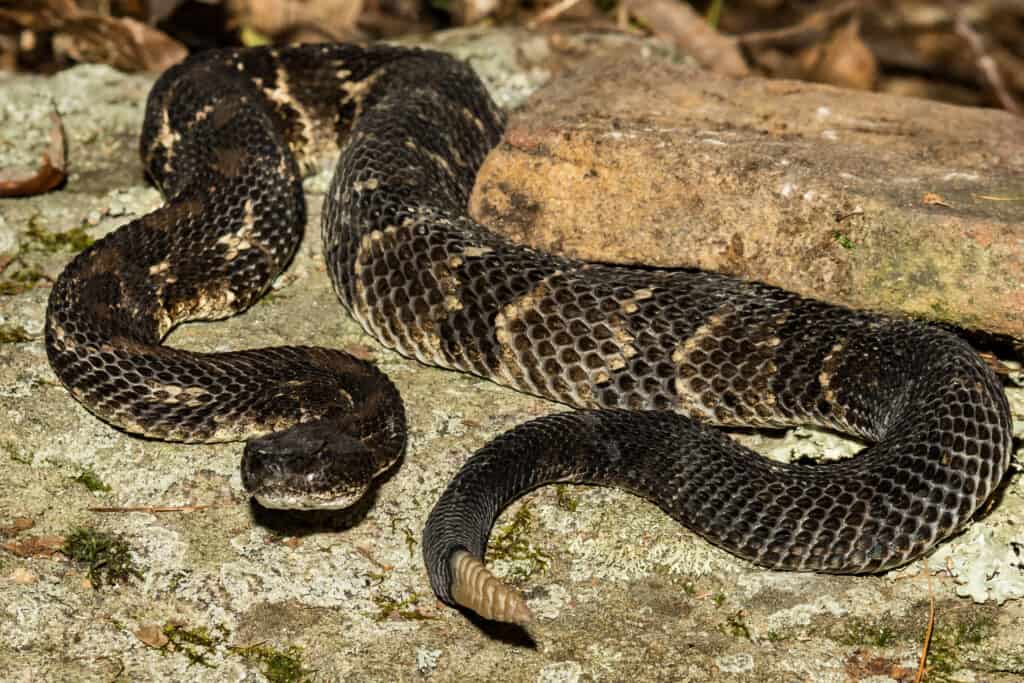
Most timber rattlesnakes prefer mountainous habitats in Delaware.
©iStock.com/JasonOndreicka
| Timber Rattlesnake | |
|---|---|
| Range | Southern Delaware |
| Length | 36-60 inches |
In the past timber rattlesnakes mostly lived in the southern half of Delaware, but today there are very few left in the state. These snakes prefer mountainous habitats with dense pine or deciduous forests and rocky outcroppings. However, they may also be seen in farm fields, swamps, and river floodplains as well. They are excellent climbers, and some have been seen in trees higher than 80 feet off the ground!
In addition to being rare in Delaware, timber rattlesnakes are also shy, nonaggressive snakes that avoid humans as much as possible. If you do happen to come across a timber rattlesnake, you might not even see it! That is because these snakes prefer to avoid confrontation, and instead, use their camouflaged colors to blend into their environment. When they feel threatened, timber rattlesnakes will coil up and rattle their tails loudly in a warning. If they are continually harassed, however, they will strike.
What Do Timber Rattlesnakes Look Like?
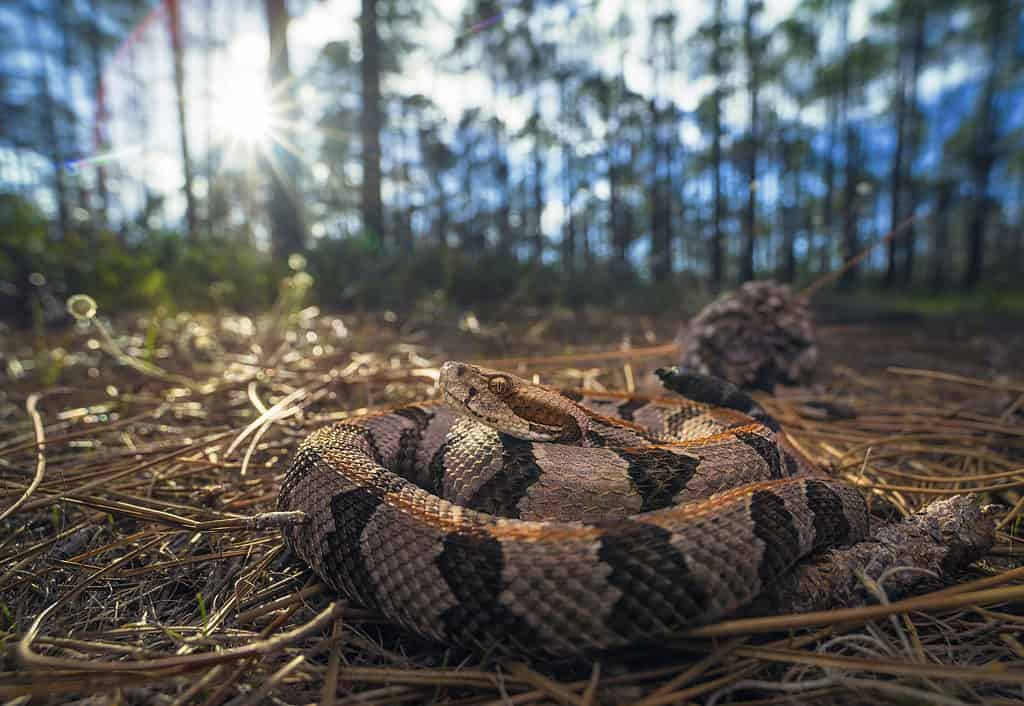
Timber rattlesnakes are large snakes and grow between 36 to 60 inches, sometimes larger.
©Kristian Bell/Shutterstock.com
Timber rattlesnakes are big snakes that usually grow between 36-60 inches in length, although some can grow much longer. In Delaware, these snakes are seen in many different colors, such as greenish, tan, brown, or dark gray, often with a pinkish hue. They have dark chevron-shaped crossbands, and many snakes here also have an orange, pink, or brown stripe running down the middle of their backs. Some snakes are so dark, however, that they appear almost completely black.
Like other pit vipers, timber rattlesnakes have very large, triangular-shaped heads with two large pits between their eyes and nostrils. These pits are heat-sensing organs that help timber rattlesnakes to detect prey as well as predators. Most rattlesnakes will have a large, iconic rattle at the end of their tails as well. However, baby rattlesnakes often only have one button or segment, and the rattles of older snakes can break off occasionally.
Although they very rarely bite, timber rattlesnakes are dangerous because they have large fangs and a high venom yield. A timber rattlesnake bite can cause seizures, severe shock, deep tissue damage, and internal bleeding. If you are bitten by a rattlesnake, it is vital to get medical attention right away.
Staying Safe From Timber Rattlesnakes
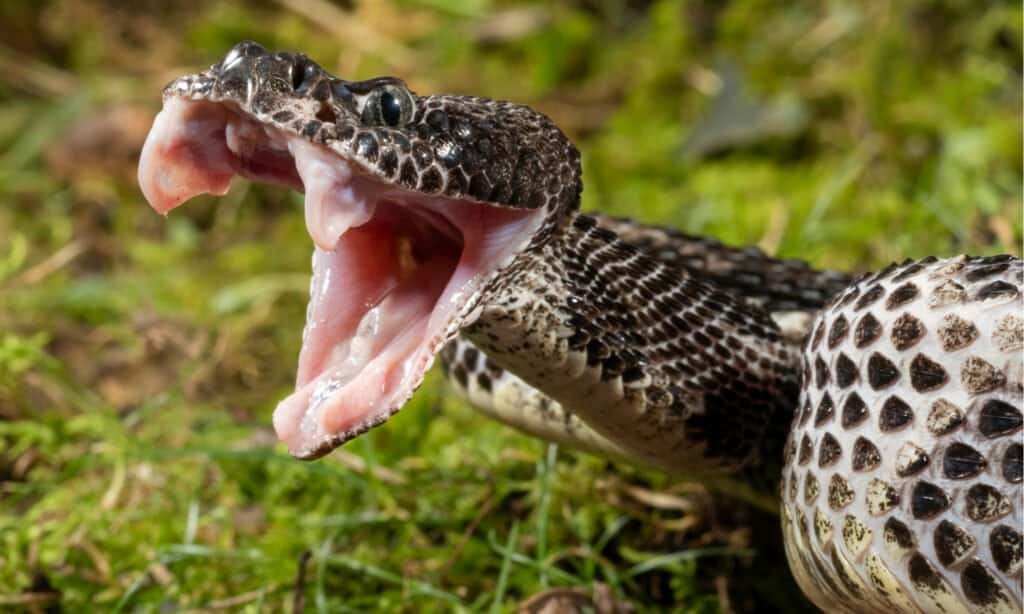
Timber rattlesnakes are highly venomous and possess large fangs.
©Joe McDonald/Shutterstock.com
Timber rattlesnakes are most commonly encountered in the spring when they emerge from their winter dens. During this time males are actively searching for females to mate with, and many snakes spend time basking in the sun to warm their cold-blooded bodies. Since they try to stay clear of humans, you will likely only encounter these snakes if you are out hiking or camping. Here are a few tips to keep you safe:
- You should wear long pants and boots if you go hiking in Delaware and keep a close eye on where you step. Many bites from Timber Rattlesnakes occur because the snake was stepped on by accident!
- If you do happen to see a snake, stay calm, give it a wide berth, and leave the snake alone.
- Never attempt to scare a snake away or move it with a stick, even if you think the snake is dead. Even a dead timber rattlesnake can deliver venom through its fangs.
- Be careful if you attempt to move any natural debris (piles of leaves, wood, rocks, etc.). There may be a snake hiding underneath! If you can, always use a rake or shovel instead of your hands.
- Do not let your dogs sniff at piles of natural debris either.
What To Do If You Are Bitten By A Timber Rattlesnake
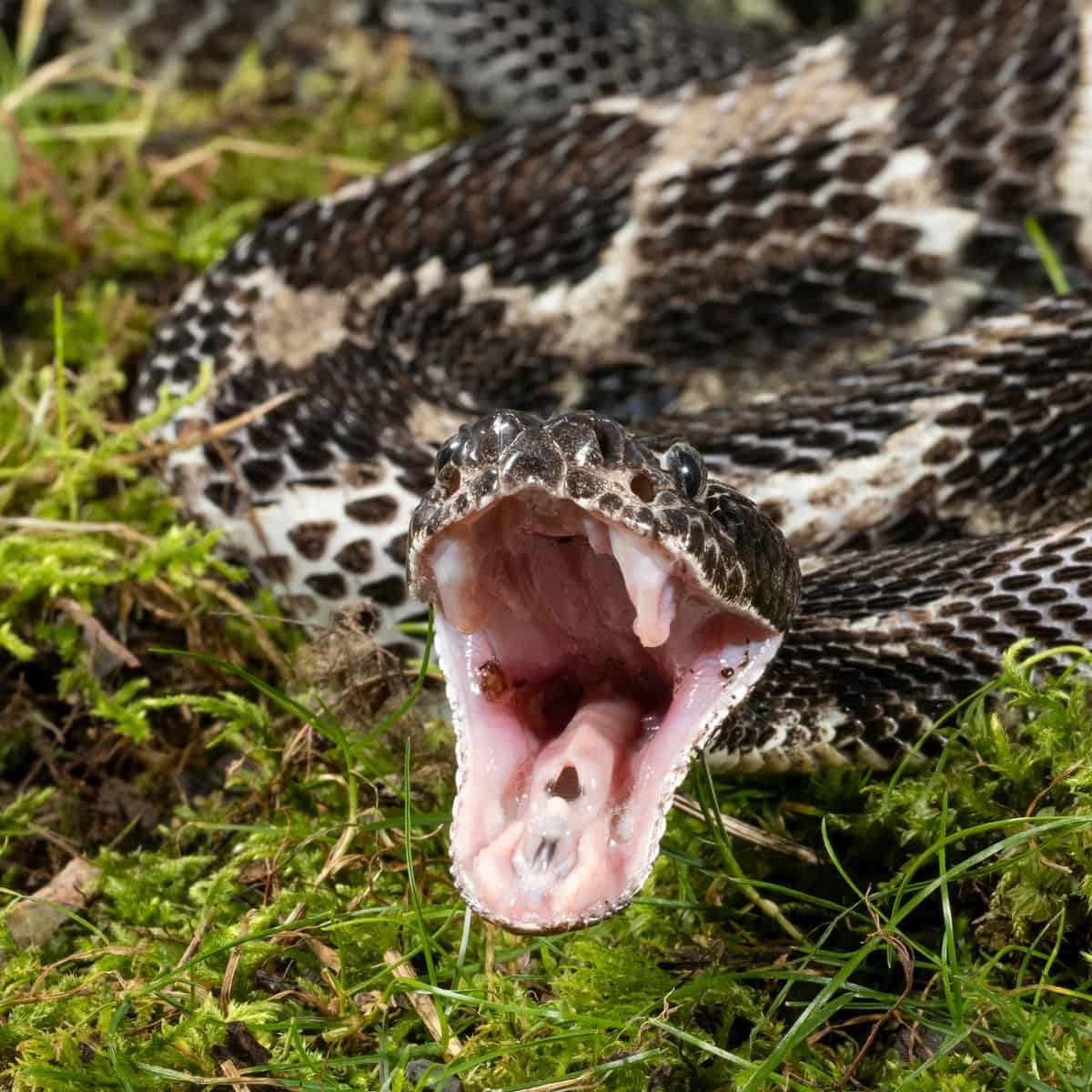
Timber Rattlesnakes strike quickly
©Joe McDonald/Shutterstock.com
Now, if you do happen to receive a bite from a timber rattlesnake, do not panic! While these snakes are highly venomous, a rattlesnake bite is not a death sentence. In fact, very few deaths occur from rattlesnake bites in the United States. If you are bitten by a snake, remember these tips:
- STAY CALM.
- Do not try to catch or harm the snake—it will already be irritated and will easily strike a second time.
- Do not apply a tourniquet, and do not cut or try to suck out the venom. This does not work, no matter how many Westerns you’ve seen.
- Do not apply ice or try to clean the wound out with water.
- Calmly get yourself to a hospital as soon as possible and try to keep your heart rate down. Do not wait to see if there are any symptoms from the bite before getting medical attention.
Snakes That Might Be Mistaken For A Timber Rattlesnake In Delaware
While only two species of snake in Delaware are venomous, there are many snakes that you might mistake for a timber rattlesnake. Here are a few examples of the rattlesnake “look-a-likes” you might see in Delaware.
Eastern Hognose Snake (Heterodon platirhinos)
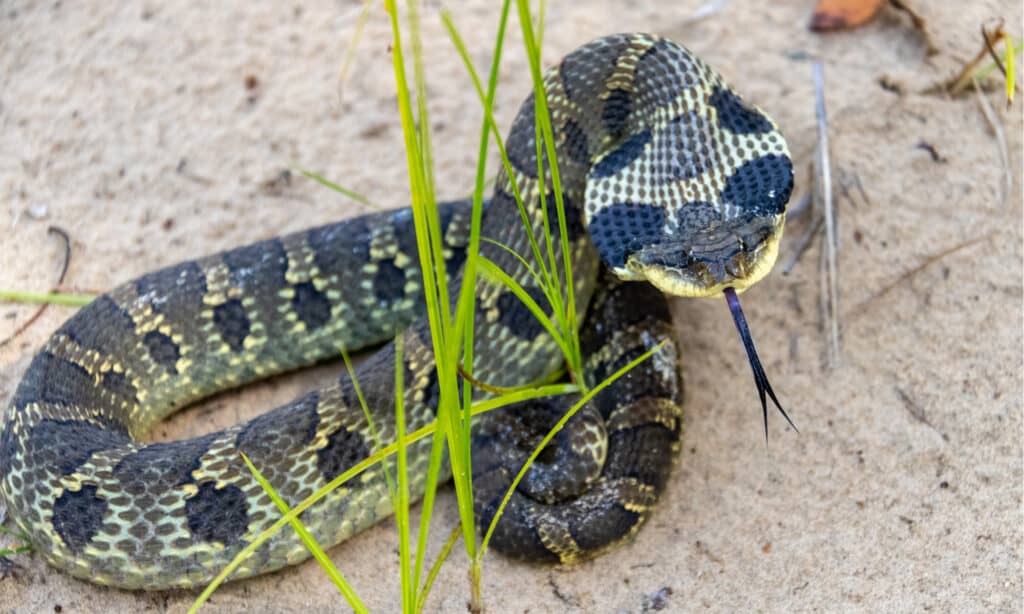
Although smaller and not venomous, eastern hognose snakes are often mistaken for rattlesnakes
©IHX/Shutterstock.com
| Eastern Hognose Snake | |
|---|---|
| Range | All over Delaware, but rarely encountered. |
| Length | 20-30 inches |
Unfortunately, many people mistake the eastern hognose snake for a dangerous snake in Delaware. Eastern hognose snakes come in a variety of colors and patterns, but are typically smaller than timber rattlesnakes, growing only 20-30 inches long. Many eastern hognose snakes can look like small rattlesnakes, and they even mimic rattlesnakes when they are threatened by rising up, hissing loudly, and rattling the ends of their tails. However, these harmless snakes not only lack rattles on the ends of their tails, but they also have upturned snouts and wide necks that make them look like miniature cobras.
Common Water Snake (Nerodia sipedon)

The common water snake has a similar appearance to the timber rattlesnake
©Patrick Coin / CC BY-SA 2.5 – License
| Common Water Snake | |
|---|---|
| Range | In or near bodies of water throughout Delaware |
| Length | 24-54 inches |
Another of Delaware’s large snakes is the common water snake. Although this snake is nonvenomous, it can be intimidating due to its large head, heavy body, and often irritable nature. Common water snakes are usually reddish-brown, brown, gray, or black, with dark brown blotches or bands along their backs. Younger snakes are usually brighter with more distinct patterns, while older snakes are much darker. Like their name, common water snakes are usually seen in or around water. Although they are nonvenomous, their main defense is biting, so it is best to leave these snakes alone.
Other Snakes Found In Delaware
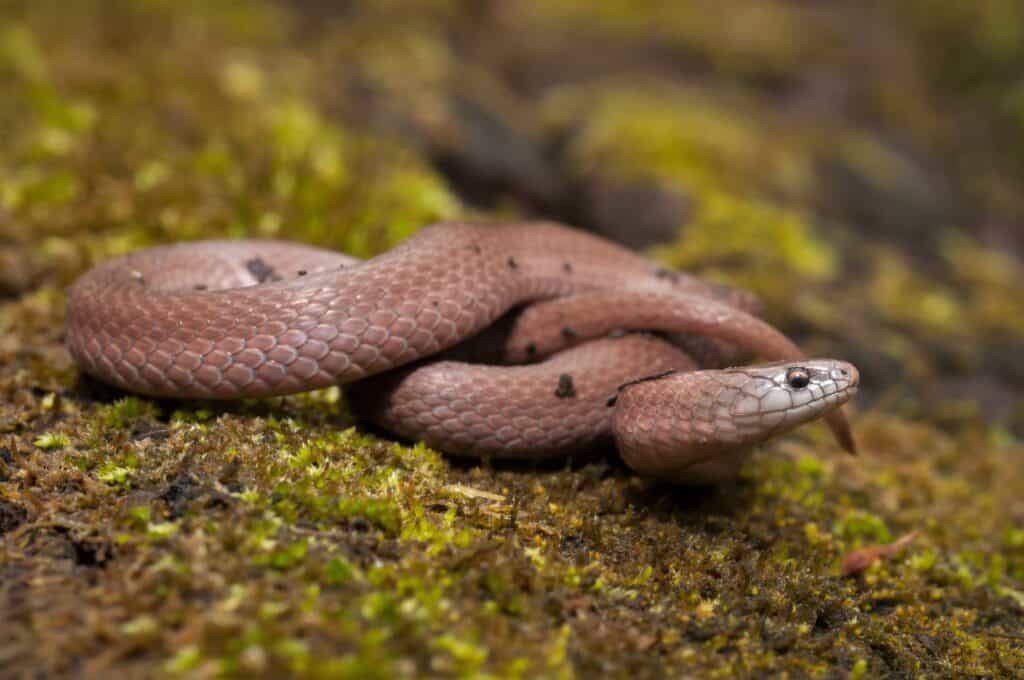
Smooth earth snakes are often mistaken for other small snakes like ring-necked snakes and De Kay’s snakes.
©Mike Wilhelm/Shutterstock.com
One of the many non-venomous snakes found in Delaware is the smooth earth snake. This small, glossy brown or reddish-brown snake can grow to lengths of between 7 to 10 inches and are not a danger to humans or pets. They are usually found in forested areas and have a diet of mostly earthworms, although snails and slugs may fall prey to them as well. This is a docile, delicate little snake that may oftentimes get mistaken for an earthworm.

A black rat snake’s bite may be painful but is non-venomous.
©Psychotic Nature/Shutterstock.com
Out of the 19 species of snakes that call Delaware home, the black rat snake, also known as the Eastern rat snake, is just one of the 17 non-venomous varieties. These serpents do still bite, however, and their bites are rather painful and contain many bacteria that can lead to infections. They can grow between 3.5 to 7 feet long and may be found in farmlands, fields, woodlands, and suburban areas. The rat snake is one of many snakes that when threatened, emits an offensive-smelling odor to ward off predators.
The photo featured at the top of this post is © Joe McDonald/Shutterstock.com
Discover the "Monster" Snake 5X Bigger than an Anaconda
Every day A-Z Animals sends out some of the most incredible facts in the world from our free newsletter. Want to discover the 10 most beautiful snakes in the world, a "snake island" where you're never more than 3 feet from danger, or a "monster" snake 5X larger than an anaconda? Then sign up right now and you'll start receiving our daily newsletter absolutely free.
Sources
- Dove Med, Available here: https://www.dovemed.com/diseases-conditions/timber-rattlesnake-bite/
- Delamere State Gov, Available here: https://dnrec.alpha.delaware.gov/outdoor-delaware/snakes-to-watch-out-for/
- Virginia Herpetological Society, Available here: https://www.virginiaherpetologicalsociety.com/reptiles/snakes/eastern-hog-nosed-snake/eastern_hognose_snake.php
Thank you for reading! Have some feedback for us? Contact the AZ Animals editorial team.







